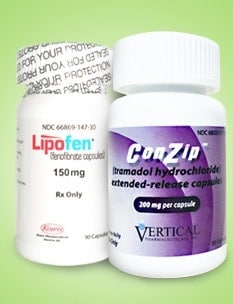

Risk is relative.
In the middle part of the last-decade, when income trusts were all the rage, Mississauga’s CML Healthcare, a more than three-decades old medical imaging company, decided to bite. One problem though; its drug development division, which was burning cash, would have to go.
Cipher Pharmaceuticals (TSX:DND), the resulting spinoff, transitioned from being defined by its relative risk to being notable for its comparative safety. Unlike many of its newfound peers, Cipher did not intend to spend years tied up in clinical trials and testing. Cipher’s Lipofen, a cholesterol treatment, has been providing a revenue stream for nearly five years, and chronic pain treatment Tramadol recently entered the market. Cantech Letter caught up with Cipher CFO Norman Evans, to talk about how the company has become a “de-risked” story with big time potential.
Norm, could you fill us in on how Cipher got started?
The company began as the drug development division of CML Healthcare, back in 2000. Once CML decided to become an income trust in early 2004, it was clear they couldn’t have a division that was burning cash and still operate under the income trust model. So they decided it made sense to spin Cipher out, and that’s when we started trading on the TSX, in the spring of 2004. All the existing shareholders of CML Healthcare received shares of Cipher. We were spun out with about $30-million in cash to continue the drug development process, so we didn’t really have to go out and raise any funds for quite a while. But in the spring of 2006, when the share price was up around the $4.50 to $5 range, we did a bought deal to raise another $12-million. That money has carried us through to today, and we still have about $10-million of cash. We have generally been cash flow neutral in the last couple of years, because we do have a revenue stream from the first product we commercialized.
What about the people involved?
The senior executive team is made up of three individuals; Larry Andrews is our CEO, he has been with Cipher in different capacities for a little more than eight years, and he moved into the CEO role in August 2006 when Dr. John Mull stepped down. Dr. Mull, who was the founder of CML, received about 40% of our shares upon spinout, and still holds close to a 40% interest in the company. Larry has extensive experience in the Canadian pharmaceutical market, playing a lead role in the licensing of more than 25 compounds and he has marketed both innovative and generic products. Dr. Jason Gross, our Vice President of Scientific and Medical Affairs, joined in June 2006. He was with MDS Capital prior to that, providing scientific guidance to investee companies. He has valuable background from his years working for the FDA, and he manages all our clinical trials and takes the products through the whole regulatory approval process. I joined in March of 2007, I’m a Chartered Accountant, and I was a partner at Ernst and Young. I moved from there to MDS Health Group in 1996 and was there for ten years, primarily working on the acquisitions that built the contract research organization, following which I was VP Finance in MDS Pharmaceutical Services prior to joining Cipher in March 2007.
You mentioned the company was spun out because of the speculative aspect, but compared to many of your current peers, Cipher is much less speculative because you have products in the market. Perhaps we could talk about them, beginning with your most mature product, Lipofen…
Sure, the theory behind all our products is that we don’t have to take them through the entire clinical development program to get them approved by the FDA because they are existing formulations and active ingredients and the FDA already has a safety profile related to these products. So in theory the clinical program should be compressed and the time-to-market – relative to a new chemical entity – should be faster. We like to think of Cipher as a “de-risked” story because we have two approved products and we have commercial distribution deals in place on those two products, so we do have multiple revenue streams, which is fairly unique for a company of our size. On our first product, Lipofen, we have had a revenue stream since the middle of 2007.
What is Lipofen?
Lipofen is a novel formulation of fenofibrate, used in the treatment of hyperlipidemia, a cholesterol disorder. The product was approved back in 2006. By the time we got the product to market, there were competing formulations and so the product differentiation in this case is subtle. But it does, in fact, play in a very large market, one that is worth $2-billion. And we succeeded in getting a distribution deal in place to show that this management team could take a product all the way from start to finish. Our partner is Kowa Pharmaceuticals who are very focused in the space that Lipofen is in. They expanded their coverage to over 250 reps by 2010 because they were planning on launching a product called Livalo which is a new statin, and is a complementary product to ours. That was really beneficial, because this product is very sensitive to the amount of focus it gets in a doctor’s office. Having so many more reps in the field dramatically increased our market penetration and our royalty stream. By the middle of 2010, Lipofen sales had flattened out because Kowa had launched their second product, and Lipofen was no longer in first position. But in return for going from first to second place our royalty percentage increased from 13% to 15%, so there was a bit of an accommodation there. Kowa, however, had a big managed healthcare win last year and so sales have actually picked up again. We achieved a sales milestone that triggered a million dollar payment from Kowa, which we announced in February.

As of Q3, 2011 Lipofen is not your only product on the market. Can you talk a little bit about Tramadol?
Sure. Tramadol is for moderate to moderately severe chronic pain, such as osteoarthritis. This is another product that when we began development we thought might be first to market, and it just so happened that there were two other Canadian companies that were involved in the development of the once-per-day Tramadol product. Ultram ER and Ryzolt were the first two to hit the market, and we ended up being third. It was primarily because of regulatory hurdles, FDA approval and things we had to do to get the product approved. But we still believe that it is a best in class product. Our formulation has a very fast onset and has no food effect. Ultram has a much slower time to reach therapeutic levels and for an extended release product, if you are only taking it once per day you don’t really want to wait four hours for the product to have an impact. Ours is a capsule product, the other two are tablets. In the US market, we’re the only promoted product on the market.
So it sounds to me that you believe Tramadol is more differentiated that Lipofen. Does this mean you believe it will have a greater chance of producing more revenue?
Tramadol is in a very large market and it is still growing. Our goal is to go after the extended release portion of the market and then hopefully start to penetrate the immediate release market. There is quite a price difference between the extended release tablets and the generic immediate release tablets which the patient might have to take four or five times per day. We haven’t really come out with any forward looking statements on expected levels of revenue for this product. We think it should be at least as beneficial to us as our Lipofen product. But it’s still early days, we have only released the US product, which is called ConZip, “Con” for consistent pain relief, and “Zip” for fast action, with our partner Vertical Pharmaceuticals, back in late Q3. The load-in revenue was encouraging, but it is going to take time to see if the penetration is there to see what kind of growth we are going to have.
What do you have in the pipeline? What follows Tramadol?
The key one we have right now is CIP-Isotretinoin, which is for the treatment of severe nodular acne. There are several versions of this product on the market in the U.S. However, there is a weakness with the products out on the market, including Accutane, which is that they have a very significant food effect. Accutane and the other formulations have a significant falloff when taken on a fasted basis versus a fed basis. The population for an acne medication, primarily, is teenagers and young adults. The question is, “How many of them have a high, fat fed meal twice per day at the time they take their pill?” We think our product has the potential to greatly improve patient compliance. It’s still the only molecule that works on severe nodular acne. So if our other products are not clearly differentiated or were not first to market, this is one where we feel we hit both of those key elements. We will be first to market and this is a clearly differentiated product.
Would you say that the real expertise of Cipher Pharmaceutical is in the clinical and regulatory aspects of bringing products to market?
Yes, that’s exactly right. Just to give you a sense of the size of the company, we only have twelve employees. So we basically have people that act as project managers, and if we need specific expertise in a given area we will contract that in. And when we do get involved in clinical trials we outsource to contract research organizations to complete them. We have the skill set to identify the product candidates, we have the people that license them in and then we have the people that take them through the clinical trials, managing the process. On top of that we have a great base of regulatory experience to take products through the FDA approval process. Once a product is approved we license it out and take in a royalty stream. We don’t incur any of the costs after the product has been licensed out. We have our sweet spot in the middle of the process.
What is your outlook for 2012?
We have several value-driving milestones in 2012, including increased royalties from our two commercial products; our regulatory action date for CIP-Isotretinoin; and portfolio expansion as we continue to look for opportunities to expand our products through in-licensing, acquisitions, or a combination of strategies. We are also actively pursuing out-licensing agreements for our current products in other territories. In short, 2012 is shaping up to be an eventful and exciting year for Cipher.
Leave a Reply
You must be logged in to post a comment.





 Share
Share Tweet
Tweet Share
Share




Comment